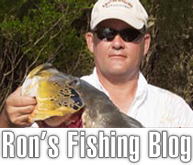History of Bass Fishing at El Salto
 [Editor: this article first appeared on www.ronsfishingblog and may only be used by permission of Ron Speed]
[Editor: this article first appeared on www.ronsfishingblog and may only be used by permission of Ron Speed]
Today I am going to talk about the history of bass fishing at Lake El Salto in Mexico. Over the past 40 years there have been several good bass lakes that came in with a big bang. We had Toledo Bend, Sam Rayburn, Hidalgo, Dominguez, Baccarac, Guerrero, El Salto, Comedero, and Lake Fork.
The three lakes that got the most publicity were Lake Guerrero, Lake El Salto, and Lake Fork. There is not one single American bass fisherman over the last 40 years that hasn’t heard about these three lakes. Lake Guerrero was smoking hot in the early 1970s with huge numbers of 3.5 lb to 4 lb bass that would bite almost any kind of lure. This lake was close to the Texas border and was easy to get to pulling your own boat.
I built two camps on this one lake because after the first camp we opened we were still turning away hundreds of clients. The first camp Jose Martinez and I built was located on the big lake about 300 yards from the water. It was called “La Retama.” It was greatly affected by the strong winds and it was very hard to fish out of this location. The second camp was on the Purification River and was protected from the high winds and this camp we named “El Sargento.”
This all started in late 1972 and by 1976 we were no longer catching those 3 to 4 lb fish. The thousands of Americans came and hauled out thousands of pounds of bass filets. We too were guilty of the misguided idea that the lake was so big you couldn’t fish it out. WRONG!!!!!!!
The one thing I learned from the Guerrero years was to never build a camp off the water like we did when we built “La Retama.” Not all fishermen want to get up at the same time and you always have a problem with transport, since 300 yards is just too far for clients to walk.
Let’s now fast forward from the mid 1970s to 1990. The Mexican government had completed building a small lake 50 miles north of the seaside city of Mazatlan. It was called Lake El Salto by the local people. We were already operating on Lake Comedero, which is much higher up in the mountains than Salto.
I went down and fished Lake El Salto when it was new and found the fishing very good and I recommended to Roberto that we have a camp on this lake ASAP. I felt we maybe could get two good years out of it before the netters would ruin it. Nets had already taken their toll on Hidalgo, Dominguez, Obregon, Baccarac, and scores of other lakes in Mexico. Roberto and I had been fighting the netters already for over 20 years and we had lost every single battle.
I used a fantastic guy from Los Mochis who was recommended by my partner Roberto Balderrama to help me get the camp started. His name was Lic. Jesús Pinedo. He was a retired engineer from the corps of engineers and had built several lakes in Mexico. Jesús and Carlos Lizarraga from Mazatlan spent maybe 3 months researching the area around Lake El Salto and we finally decided on a very beautiful site that was hidden from lots of boat traffic.
Jesús and I had several long talks on where to build the El Salto camp. Jesús wanted to build the camp about 200 yards from the waters’ edge so as to not ever have the water get up into the camp. I remembered 20 years earlier and my mistake on Lake Guerrero and I wasn’t going to make the same mistake on Lake El Salto. I asked Pinedo how much damage would we incur if the water did get up into the camp. Jesús figured for about 30 minutes and said with that type of construction it might cost $10,000 in damages.
 That amount of damage was nothing in comparison to the cost of running a bus with a driver, so I advised Pinedo to build the camp at water’s edge. I knew our clients would enjoy a camp that was one minute from bed to boat. This recommendation came from another experience of mine 20 years earlier in Central America. Chuck Pearce and I made a fishing trip to Costa Rica to a fishing camp called Casa Mar. We were fishing for tarpon and big snook. I absolutely fell in love with that camp, so I drew up a model for Pinedo to use in construction of camp El Salto.
That amount of damage was nothing in comparison to the cost of running a bus with a driver, so I advised Pinedo to build the camp at water’s edge. I knew our clients would enjoy a camp that was one minute from bed to boat. This recommendation came from another experience of mine 20 years earlier in Central America. Chuck Pearce and I made a fishing trip to Costa Rica to a fishing camp called Casa Mar. We were fishing for tarpon and big snook. I absolutely fell in love with that camp, so I drew up a model for Pinedo to use in construction of camp El Salto.
There were NO CAMPS on Salto lake at that time and I had my doubts that the lake would last long enough for anyone else to build anything. Man, oh man was I wrong!!!!!!!!!!
We operated maybe 2 years and sure enough, most of the 3 pound bass and larger were gone and our clients got tired of catching small bass. We got the help of Helen Collard, the Head of the fishing department in Mazatlan, and got permits to bring Florida bass from the USA and stock Comedero and Lake El Salto. We closed down the camp for 3 years and moved to Lake Obregon in the state of Sonora.
We actually should have closed the camp earlier as a lot of clients lost faith in fishing Lake El Salto. However, while we were gone a new camp opened on Salto and began catching the Florida bass. The camp was not on the water–maybe 300 yards up on a hill–but the fishing was very good. We decided that fall we would reopen our beautiful little camp by the famous 100-year-old Capulin tree.
 That next year we had the owner of Bass Pro Shops, Johnny Morris, come to fish with us at Comedero and he brought Bill Dance and Porter Wagoner and Porter caught our first 14-pound Florida bass. That big bass signaled the start of something incredible as hundreds of 10 pound fish were caught out of Lake El Salto that year and the lake became as famous as Lake Fork in Texas.
That next year we had the owner of Bass Pro Shops, Johnny Morris, come to fish with us at Comedero and he brought Bill Dance and Porter Wagoner and Porter caught our first 14-pound Florida bass. That big bass signaled the start of something incredible as hundreds of 10 pound fish were caught out of Lake El Salto that year and the lake became as famous as Lake Fork in Texas.
A dream come true for most American bass fishermen is to get to fish lake El Salto just one time in their life. The chance of catching a 10-pound bass is probably better on Lake Salto than on any other lake you could fish.
To end this history lesson on Salto, I will say I was 1000% wrong about the life of this wonderful lake. I predicted it would not last more than 2 years and it is still going strong after 20 years. We have just finished building a new camp in the same location as the original Casa Mar style camp (pictures coming soon!). I will only say that as long as the locals protect the black bass like they have been doing, the lake might last another 20 years.
HAVE FUN WITH YOUR FISHING AND WEAR THAT LIFE JACKET

